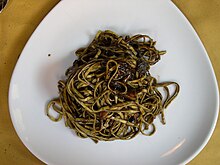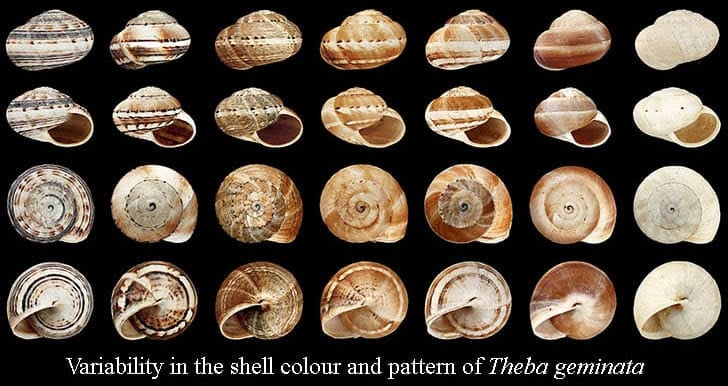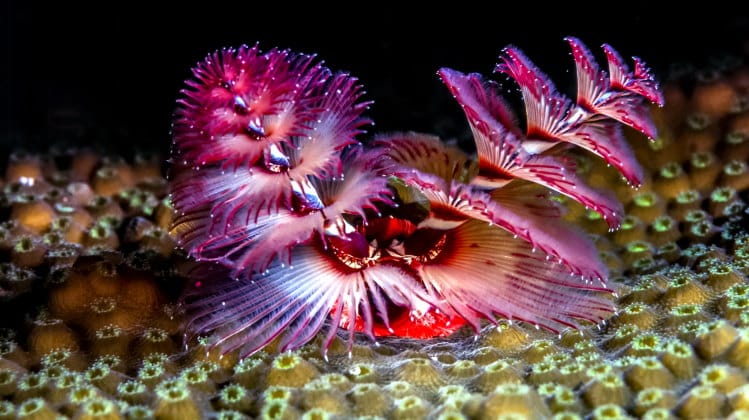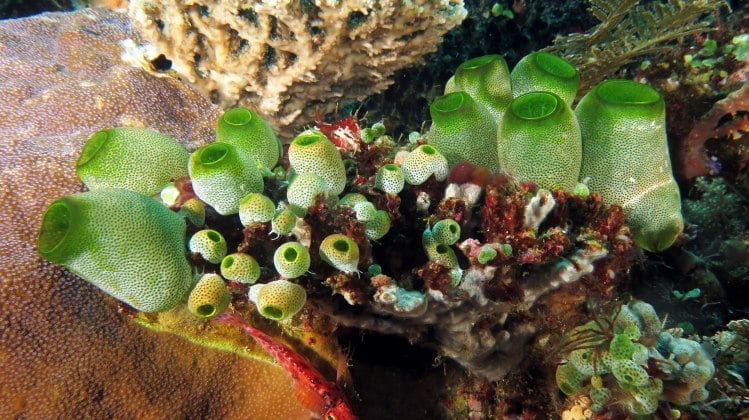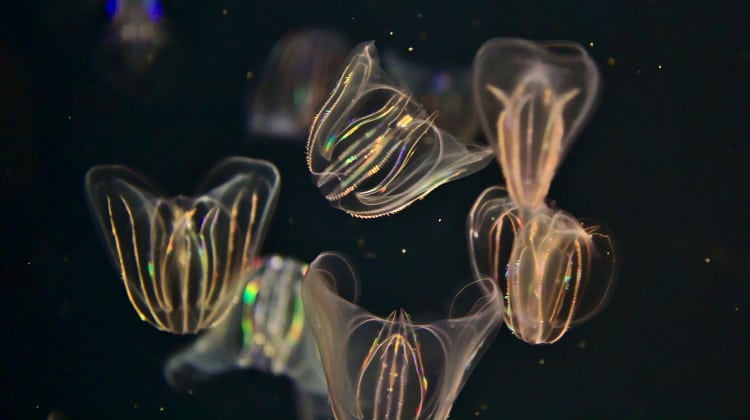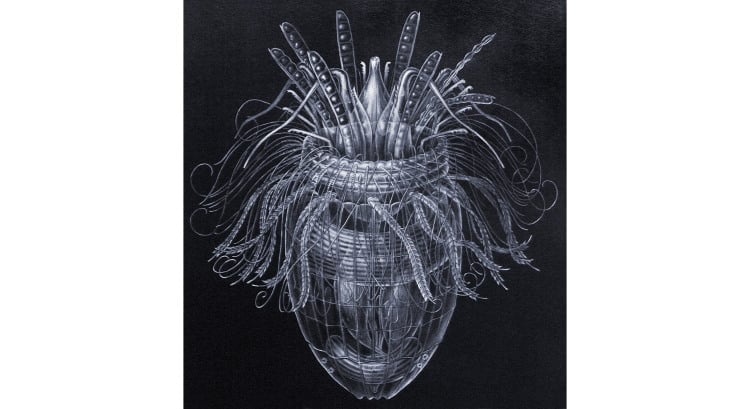Cuttlefish: Colourful Living Artists of the Oceans
Cuttlefish are amazing creatures. Intelligent, underwater living works of ephemeral art; they are often called the chameleons of the sea.. Their incredible beauty is adaptable and constantly changing, it is impossible to become bored watching them. We are only just beginning to learn about the true complexity of their short lives.
Like all the coleoids cuttlefish represent relatively recent branching away from the ancestral cephalopod line. The earliest recognizable fossil cuttlefish date from the mid-cretaceous period (circa 100 MYA) during the reign of the dinosaurs. However, molecular clock analysis by Tanner & Fuchs et. al. 2017, suggest they first separated from the common cuttlefish/squid ancestor about 180 MYA.
While cuttlefish share many characteristics with their cousins the octopuses and squid they are unique in their possession of cuttlebone. Cuttlebone is a compact arrangement of numerous wafer thin segments of aragonite (a form of calcium carbonate). It evolved out of the old cephalopod shell and in cuttlefish today serves as an organ of buoyancy.
One of the amazing things about cuttlefish and their close relatives is there ability to regenerate lost (to predators) arms. Meaning if a predator bites, or twists off an arm, they can grow this arm back. This characteristic of coleoid cephalopods was commented on by Aristotle 2350 years ago, but it is still not fully understood, and it fascinates scientists. While mostly observed in octopuses, cuttlefish are also capable of this very useful trait. In two species that have been scientifically studied, Sepia officinalis and Sepia pharaonis a 10% to 20% loss of an arm was regrown in about 40 days.
Etymology:-
A cuttlefish is called a fish, because in old English most creatures from the sea, or other waters, were a fish of some sort (i. e. Starfish, Jellyfish), in the same way that all small flying things were flies (i.e. Butterfly, Caddisfly). The “cuttle” in cuttlefish comes from the Old English word, cudele. This supposedly relates to the cuttlebone.
The ancient Greeks, Romans and other Mediterranean cultures were quite familiar with the cuttlefish and prized it for its brown ‘ink’. The word for cuttlefish in both ancient Greek and Latin was sepia. This word is now now refers to the reddish-brown color sepia in English.
Cuttlefish are grouped together in the Sepiida, one of the eight Coleoid, and six Decapodiform orders of the class Cephalopoda. As such they are all actively hunting predators with, ink sacs, siphonic jet propulsion, eight arms, two tentacles and numerous chromatophores. Their arms bear numerous suckers and the tips of their tentacles also have suckers.
According to the Catalogue of Life There are currently 196 species, (divided into three families), of Sepiida known to humanity. In some classification schemes the Sepiolida (Bob-tailed Squid) are recognized as a separate order in their own rite. There are several aspects of their biology that separate them from the rest of the cuttlefish including the fact that they lack a cuttlebone. Hopefully I will find time to write more about them soon.
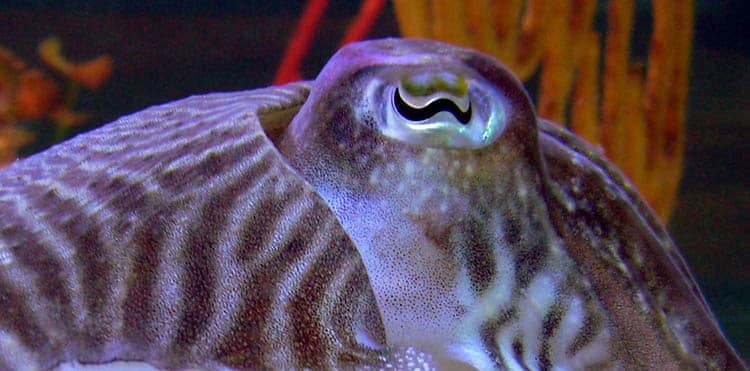
Basic Cuttlefish Biology
The largest species, the Giant Cuttlefish (Sepia apama) reaches lengths of 50 cms in its body and up to 90 centimeters arms and tentacles included. The smallest species is the Agulhas Pygmy Cuttlefish (Sepia typica) grows to only 3.6 cms (1.4 ins) in length. Most species are somewhere between 12 and 25 cms in body length.
Cuttlefish are voracious and active carnivores. They appear to prefer crustaceans as their main dietary choice, and they also enjoy fish. However they will also eat other smaller cuttlefish if the opportunity arises. Their hunting technique involves a slow stalking of the prey followed by a last second rapid attack using their highly extensible tentacles to capture the prey and draw it in to their mouths.
As primarily visual hunters cuttlefish have large eyes and wonderful eyesight. Their eyes are instantly recognizable because of their highly distinctive drunken W-shaped pupils, but are, as far as we currently understand, they are colour blind. They have large brains and far greater intelligence than we as a species have understood to date.
As well as the various mechanisms for colour transformations cuttlefish also possess numerous papillae that allowed them to transform their skin texture. There is a unique muscular hydrostat system in their skin (also in octopuses). When this system is expressed, dermal protrusions called papillae disrupt body’s appearance allowing the animal to imitate the basic texture of surrounding objects. Like the chromatophores this system is under full neural control.
Like their closer cousins the octopus and the squid they live short bright lives. Growing quickly they mature in just one or two years, reproduce and die. In all the species studied to date the female dies after deposing her eggs somewhere. In their short intense lives they bring a wealth of colour and fascinating behaviour to our oceans. We are still learning so much about these amazing creatures.
Lifestyles and Ecology
Cuttlefish, like all the Cephalopoda are strictly marine invertebrates. Technically, the Sepiida are described as being benthic (they live near the sea floor), neritic (they live near the coast in shallow waters) marine carnivores. Their distribution therefore is limited to the warmer coastal waters of the world and they prefer tropical to temperate waters. Furthermore, they are usually found in relatively shallow waters, making them easy for divers to study. However, individuals have been noted at depths of 600 meters (2000 ft).
For reasons that are not fully understood they are absent from the Americas. Some scientists theorize that this might be because they evolved after the American continents separated out from the rest of Pangaea. There is no coastal warmish water pathway from the rest of the world to the Americas.
Cuttlefish are an r-selected order of animals, meaning they develop quickly, have short lives and produce large numbers of young that experience no parental care after laying. Very few cuttlefish species have lifecycles that extend to two years, and many have lifecycles that are completed in less than one year. S. officinalis is considered a long-lived cuttlefish with an average lifespan of about 1.5 years. Around this average the lifecycle of S. officinalis can be as short as 15 months in the Mediterranean and as long as 22 months in the English Channel. Many species live solitary lives until the mating season arrives, however, some other species will live and forage in loose aggregations.
Cuttlefish hunt by slowly stalking their prey and then rapidly extending their two tentacles. These tentacles each have a sucker on the terminal pad that allows them to grasp the prey. Thus they use their camouflage abilities to hide from prey as well as to avoid predators. Hunting is aided by the binocular vision and the fact that like chameleons cuttlefish can exert independent focus of their eyes (something humans can not do).
Cuttlefish usually hunt crepuscularly, during the changing of the light at both dawn and dusk. They are opportunistic feeders and will take whatever they can get when hungry, even other cuttlefish. However, if food is plentiful they seem to prefer shrimps and crabs. Obviously smaller species feed on different species of prey than larger species. Generally speaking they may specialize in one type of prey early on in their lives and then adapt to other prey as they grow larger.
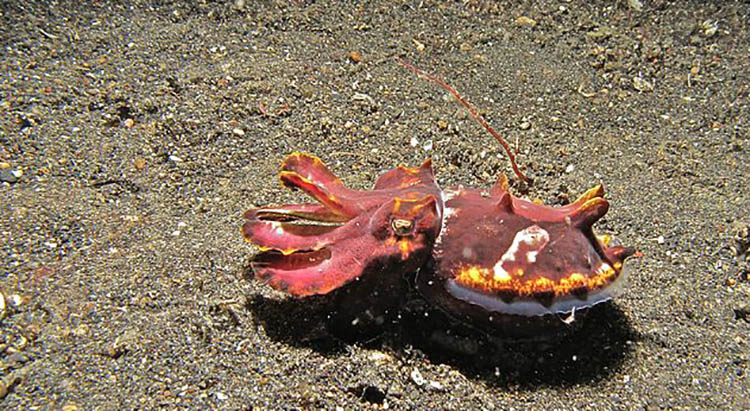
Scientists now know that cuttlefish have good depth perception, they also now know that like us (humanity and other mammals) they use ‘stereopsis’ (the ability to extract depth information from the disparity between left and right visual fields) to achieve this. (As far as is known to science neither squid nor octopuses are able to make use of stereopsis.) That this is a sign of convergent evolution (the same result evolving in two or more different ways) was proven in a paper published in January 2020 by Feord & Sumner et. al. In this paper they show that the mechanisms behind cuttlefish stereopsis differ from those of both humans and mantids, which also possess stereopsis.
Cuttlefish use their brilliant colour changing abilities not just to sneak up on their prey or to hide from predators, but also to communicate with other members of their own species. Males and females have different ‘resting patterns’ as well as more aggressive patterns and some displays we really do not understand yet. Cuttlefish differ from chameleons in that they can display completely different patterns on the left and right side of their bodies. This is mostly used in mating situations – see explanation below.
Cuttlefish; Masters of Dynamic Colouration
Colour is everywhere in the natural world and animals using colour for camouflage and communication is also not uncommon. However, animals that can change the colour of the whole body rapidly and regularly is much rarer.
In chameleons a double layered skin made of iridophores of guanine crystals are responsible for the colour changes only. Chameleons can adjust the lattice of the crystals to change the wavelengths of light they reflect. Iridophores and chromatophores are referred to as organs because they are a combination of different cell tissues, including muscles and nerves.
Skin colour changes in the Coleoid cephalopods, especially the Sepiida occur as a result of a much more complex system. Three different types of cells or small organs, chromatophores, iridophores and leucophores are arranged in three distinct layers of the subepidermis. Coleoid cephalopods can use direct neural control of thousands of tiny muscles to alter the degree to which these different components contribute to their skin colour from moment to moment.
Chromatophores
Chromatophores are the most complex of the cuttlefishes colour organs. Chromatophores of one kind or another occur in may animals but reach their greatest expression in Coleoid Cephalopds. Basically a chromatophore is an elastic sac of coloured material. Chromatophore pigments are typically only red, yellow, or brown, other colour effects can be created by displaying combinations of different colours.
The kin of the sac is elastic and can stretch. Circular muscles around the pigment sac can pull on the perimeter of the sac so that it expands towards the skin surface, thus becoming more visible; and they can relax, thus reversing this process. Chromatophores are tiny, a typical cuttlefish has many millions (up to 20 million) of them in its skin, and as far as we know they are all under direct neural control of the brain.
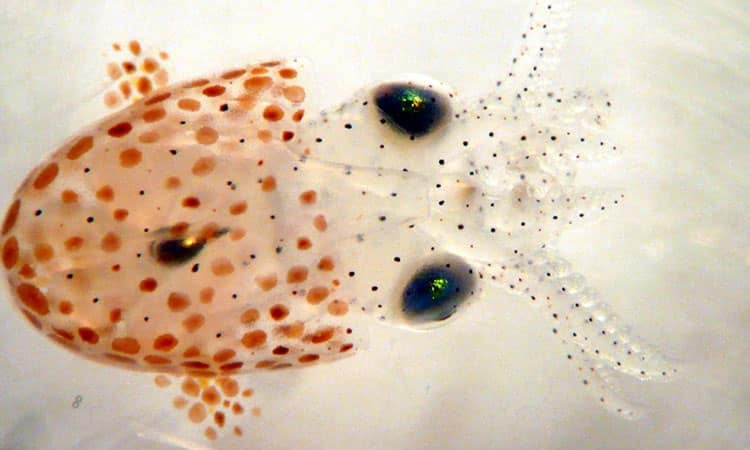
Iridophores
Iridophores exist in the animals skin as a second layer of cells, they are located below the layer of the chromatophores. Iridophores are cells that contain microscopic crystalline ridges. The cells reflect different colours depending on the distance between the ridges. Interestingly, the color an iridophore reflects is dependent on the angle of observation. When observed from above, iridophores can appear blue, but when observed at a more oblique angle, they appear to reflect red light. By combining reflection from the iridophores with the correct patterning of their chromatophores, the cephalopods can create a wide range of colours. Unlike chromatophores, it is doubtful that these iridophores are controlled directly by the animal’s brain This is because they respond much more slowly (several seconds or even minutes) than chromatophores which can be altered in less than a second. Scientists believe the control mechanism is neurohormones, but more research is needed to be sure..
Leucophores
Leucophores occur only in cuttlefish and octopuses, squid do not have them. Leucophores perform two jobs in the cuttlefish colour dynamic. Firstly, as you might expect from their name, they can supply a white colour. They do this by scattering full spectrum light. This allows the animal to have areas of clear white anywhere on its skin and to alter the intensity of colours generated by chromatophores and iridophores. Secondly leucophores can reflect the filtered light that reaches them without changing its wavelength, this is a great help in camouflage coluration.
Camouflage Patterns
Scientists have found that inn nature, cuttlefish express a disruptive pattern (of various forms) when the background is composed of discrete objects (e.g. pebbles), where as a mottled or and stippled pattern is displayed when the background is a patterned surface such as sandy seafloor. Unexpectedly, they have also found that, in the species Sepia officinalis, light coloured pebbles against a background will stimulate much more response than dark pebbles.
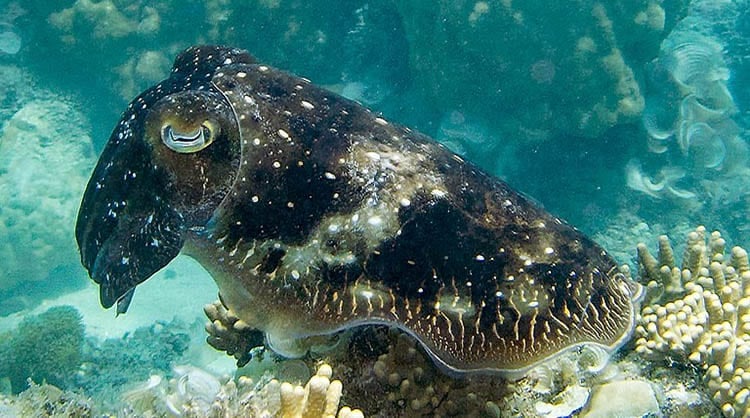
Cuttlefish Intelligence
Cuttlefish are among the geniuses of the ocean. The intellectual feats of some species of cuttlefish, though nowhere nearly as popular in general discussion as those of some Octopuses, are equally astounding. To be honest Cuttlefish have not been found to dexterously solve puzzles the way Octopus do, but neither have they been shown to be good at climbing trees. The point is that their different ways of living drive them to use their intelligence in alternative ways.
Many divers and scientists have come to believe that cuttlefish have a well above average degree of intelligence and awareness for marine creatures. They are seen to be highly aware and observant, almost interested in the diver. They are inquisitive. In his book Other Minds: The Octopus, the Sea, and the Deep Origins of Consciousness, (2017), Peter Godfrey-Smith devotes a considerable amount of space to describing his sense of the intelligence of the Giant Cuttlefish (Sepia apama). On pages 108-109 he writes the following.
“The giant cuttlefish is also remarkable in another way: how disarming it is to find friendliness in a large wild animal. I do not mean a mere toleration of a human’s presence, but an active engagement, the animal’s making contact with a foreign being. This is not routine in giant cuttlefish, but not rare either. Quite often you encounter a friendly curiosity. The animal comes forward, with its skin in a quiet ‘resting’ pattern of colours and shapes. The cuttlefish will hover close by, apparently trying to work you out.”
Science is however catching up with casual observations. In 2003 Karson and Boal demonstrated that the cuttlefish Sepia officinalis was capable spatial learning, and other experiments have since shown that Cuttlefish can solve maze problems and then remember the solutions for a considerable amount of time.
In 2008 Emma Kelman et. al published a paper showing the S. officinalis and S. pharaonis not only have good depth perception but that they can distinguish between real 3-D real backgrounds and 2-D photographic backgrounds.
In 2016 a paper was published with the title “Number sense and state-dependent valuation in cuttlefish” which demonstrated that small Cuttlefish (Sepia pharonis) is able to count, at least up to five, which was the limit of the experiment.
In another paper “Cuttlefish show flexible and future-dependent foraging cognition.” published February 2020 the authors show that the Cuttlefish (Sepia officinalis) will restrain its foraging efforts in the present if it knows it will be able to acquire a preferred food item at a later date. This means they are not only able to remember regular sequential actions in the world around them (called ‘episodic memory’), but that they are also to plan a course of action according to this data and exercise self control in order to achieve a more desired result.
More information on these, and other experiments on cephalopod intelligence can be found on the Earthlife page dedicated to Cephalopod Intelligence (coming soon).
Reproduction In Cuttlefish
Cuttlefish are dioecious, the two sexes are separate and, as far as we know, males are always males and females are always female. Cuttlefish mate head to head. The male inserts his spermatophores onto the skin around the female’s buccal cavity using a specialized (hectocotylized) arm. In those Sepiida species studied both males and females will mate more than once during the breeding period. The female lays her eggs in rock or coral crevices and pays them no further attention. Once the breeding season is over, or once they have exhausted their reservoirs of sperm or ova, the adults die
In some Sepiida species a mating pair pair swims side by side, the male indulging in some courtship behaviour with its arms before mating takes place. In captive studies of Sepia officinalis no courtship bevaviour was observed. (However, behaviours observed in captivity do not necessarily reflect behaviours in the wild absolutely.) The actual mating occurs by the pair intertwining their arms and remaining together while the spermatophores are placed on the inner side of the female’s mouth membrane. To do this the males use the modified fourth arm known as a hectocotylized arm.
The duration of mating varies between species. In some species, such as Sepia officinalis, during the first half of their 10 to 14 minute mating the male uses his syphon to jet blasts of water at the females mouth in an attempt to clear way the sperm left there by previous matings. Then using his hectocotylized arm he deposits a large ball of spermatophores (150 to 300) to the skin around the female’s mouth. During the remainder of the copulatory period he uses his hectocotylized arm to prod and break up the spermatophore to release the sperm within.
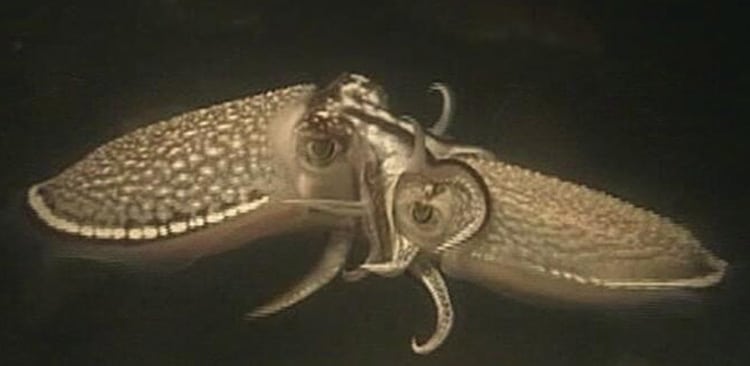
Once the Mating is Over
A female cuttlefish can continue to eat and lay more eggs for a short time after her initial mating, but she will not live to see a second mating season. S. officinalis can lay 100 to 150 eggs in one sessions. She then needs to feed and replenish the reproductive material in her ovaries and accessory glands. Exactly how many reproductive episodes such a female can live through, before her preprogrammed death catches up with her is unknown. The total number of eggs laid by a female cuttlefish is quite variable, but it can be as high as several thousands in some species. The eggs of most cuttlefish are relatively large and well supplied with yolk.
The female will deposit or attach her eggs to the substrate in some way. In S. officinalis the female creates small bunches of eggs. Because they are round and bunched, and because she adds a little ink to each egg, giving them a dark colouration, they are often called ‘sea grapes’. These eggs take between 50 and 70 days to hatch depending on the temperature of the water.
What hatches out is a miniature cuttlefish, capable of swimming, using ink as a defence and hunting down its dinner. Cuttlefish have no larva, and no larval stage. The young are simply ‘young’ or ‘hatchlings’. Young cuttlefish are voracious hunters, often tackling prey nearly as large as themselves. They grow quickly and while very small their camouflage abilities are limited, so they may bury themselves in a soft sea substrate when not hunting. Until they are ready to mate most cuttlefish live solitary lives.
Amazingly scientists have shown, that in one species of cuttlefish, Sepia pharaonsis, the unhatched young inside the egg (which becomes transparent just before hatching) can recognize an approaching predator. They respond by remaining as still as possible, even to the extent of holding their watery breath. This response to danger is also triggered by the presence of cuttlefish ink in the water. Whether this is because other cuttlefish are a danger, or because cuttlefish release ink as a predator defense (and sometimes as a response to a conspecific releasing ink) is unknown. However, scientists were able to use this response to ink to teach unhatched cuttlefish to consider clown fish a threat. Clown fish are not actually a threat and naturally cuttlefish hatchlings have no innate fear of them. This makes cuttlefish members of a very small group of animals that can learn before hatching or being born.
Males Approaching Females
As mentioned above cuttlefish can display different messages, via different skin patterns, to conspecifics on opposite sides of their bodies. In this way a male can display “Hey, look at me I’m a sexy male.” to a female on his right side, while displaying a ‘relaxed female pattern” to one or more males on his left. This allows him to court the female without alerting other males to his behaviour.
Male cuttlefish of the species Sepia apama are not all the same size, some are quite a bit smaller than others. In order to continue passing on their genes these smaller males have evolved sneaky ways of avoiding the aggressive attention of larger males. Firstly they may camouflage themselves against the background while approaching a female, so as not to be noticed by a dominant male. Secondly they will adopt and display female colouration patterns when moving close to the desired female.
Beyond mere colouration these sneaker males will hide their hectocotilized fourth arm and hold their other arms in the manner of an egg-laying female. That this deceptive cross-dressing strategy works, allowing these smaller males to successfully mate is proven not only by human observation (and genetic analysis of fertilized eggs) but by the fact that these smaller males continue to exist as a form within the gene pool.
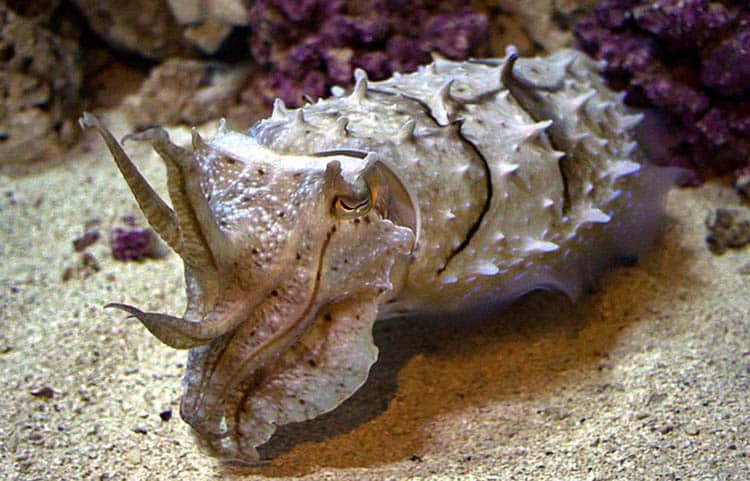
The Strange Case of the Sepia apama in Spencer Gulf South Australia.
Gender mimicry in order to achieve successful matings (or ova fertilizations in fish) without incurring the wrath of larger males was not previously unknown in the animal world. Crustaceans, fish and reptile species, are all known to exhibit some form of this behaviour . Examples include Broadley’s Flat Lizard, (Platysaurus broadleyi), the Red-sided Garter Snake (Thamnophis sirtalis infernalis) – uses female pheromones’ to distract competing males but still appears male, the Peacock Blenny (Salaria pavo), the Bluegill Sunfish (Lepomis macrochirus) and the marine Isopod Paracerceis sculpta. The big difference is that these other species are not able to change their appearance in a matter of seconds as the Giant Cuttlefish is.
The Giant Cuttlefish (Sepia apama) lives along the southern and central coasts of Australia. Its distribution extends from Moreton Bay (Brisbane) in the east to Shark Bay (Western Australia) in the west, meaning it lives along the southern half of Australia’s impressive 35,877 km coastline. Spencer bay, just west of Adelaide is roughly the mid-point of this extended distribution. For unknown reasons this area is the site of the only known definitive breeding aggregation of cuttlefish anywhere in the world.
Every winter (April to August in Australia) thousands of these cuttlefish meet up to breed along a restricted area of rocky reef in northern Spencer Gulf, South Australia. Males dominate the aggregation with the average sex ratio 4:1 (males:females) and with a maximum disparity in some places of 11:1. During their time in the aggregation both sexes will seek out and accept multiple mates, with mating lasting for an average duration of 2.4 min. Females lay eggs approximately every 6.5 minutes and will often accept more than one mate between egg laying episodes.
Males use the full range of behaviours known from the species to achieve matings, i.e. working alone or in pairs, using “open stealth,” “hidden stealth,” and female mimicry (small males only). Males choose to defend females that have accepted them rather than specific egg-laying sites. Females showed direct mate choice by rejecting 70% of more than 100 mating attempts, at times rejecting large males to mate with smaller males.
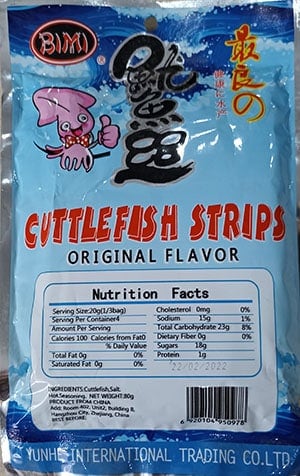
Cuttlefish and Humanity
Because cuttlefish are coastal creatures they have long been known to humanity in those areas where they exist. One of the oldest literary references to cuttlefish must be when Homer compares Odysseus to a cuttlefish attempting to hold onto rocks when he is shipwrecked in his book “Odyssey”, written about 2750 years ago. Other ancient Greek references to cuttlefish include Metagenes of Crete citing them as one component of a feast. Furthermore, in ancient Greece mythology Thetis was a goddess of the sea and the leader of the fifty Nereides. She could change into a cuttlefish.
Later, 2350 years ago Aristotle describes them in his “Historia animalium“, noticing that their anus is very close to their head. Pliny the Elder also described them in Book 9 of his “Naturalis Historia” which is dedicated to marine animals. The ancient Greeks called cuttlefish “Sepia” and the Romans adopted this name also.
Medicinal Uses
Cuttlebone is an ingredient of Traditional Chinese medicine, and has been for a long time. In a Chinese apothecary it is known as hǎi piāo xiāo. Medicinally it is Warm, Salty & Astringent; it is good for the kidneys, the liver and the stomach. It is used used as a coagulant to stop bleeding, or as an absorbent used in treating blisters. When mixed into herbal decoctions, cuttlebone is apparently a highly-effective treatment for stomach ulcers, asthma, gastritis and or diarrhea.
According to the 52 volume work Compendium of Materia Medica or Ben Cao Gang Mu (Chinese: 本草綱目) written by Li Shizhen during the Ming dynasty and published in Nanjing in 1596. “All blood diseases should be treated by using cuttlebone.”
In western ‘alternative medicine’ cuttlefish ink has been used to treat blood problems and depression for over 100 years and there is some scientific suggestion that it may be helpful to cancer patients undergoing chemotherapy. At least lab-mice given cuttlefish ink orally experienced reduced damage to bone marrow and spleen tissue when receiving chemotherapy or radiation therapy. Furthermore, there is growing evidence for sepia ink polysaccharides possessing various medicinal properties ( Sepia Ink Polysaccharides are called SIPs).
Delicious As Food
In East Asia, dried, shredded squid is a popular snack, available in corner shops much like crisps. Cuttlefish may be used to create this rather than squid. . In the Qing Dynasty the poet and scholar Yuan Mei published a book called Suiyuan shidan, (The Way of Eating) with a recipe for the roe of the cuttlefish, which was considered a delicacy at the time. Orange Cuttlefish is a quite famous Cantonese dish.
Cuttlefish are quite popular as food in Europe, especially in those countries with warmer coastlines where they have been part of the diet for a long time, but nowadays also in countries like Croatia and Montenegro. They feature in many countries in various risotto recipes. In Spain they can also be found in tapas and in Portugal they have Chocos com tinta (cuttlefish in black ink), an example of the animal being served in a sauce made from its own ink.
Finally, because coleoid cephalopods are one of the few groups of marine organisms not suffering massive population declines at the moment, eating them is likely to become more popular in the future, as suggested by this paper published in 2018; Cephalopod Gastronomy—A Promise for the Future.
Fishing and Fisheries
All this eating means cuttlefish fisheries are a booming business, although exact data is hard to find for some areas. In 2017 total landings of Sepia officinalis to UK ports was 7,182 tonnes and the total revenue generated by the first sales of this was £25.69 million. The 2021 FAO paper on S. officinalis fisheries only gives data to 2016. Globally capture of S. officinalis peaked in 2012 at 29,500 tonnes and had dropped to 23,000 tonnes by 2016.
Meanwhile in Australia, the Giant Cuttlefish (Sepia apama), is one of the few cuttlefish species with a recorded population decline, presumably due to fishing. As a result of this various places have initiated protective bans for certain areas and dates, especially in known breeding areas like Spencer Bay.
Like all cephalopods cuttlefish are not easy to culture and to date farmed specimens represent more of a scientific challenge than a commercial opportunity.
Sepia Ink
Cuttlefish ink was an important dye in times long gone in Mediterranean regions, it was called sepia, after the animal it came from. Sepia is a brownish (colour is dependent on concentration) substance whose main ingredient is melanin. It was obtained from both octopus and cuttlefish in ancient Rome, and still is. According to various blogs it is only ever used as an ink, or in watercolour paintings and was most popular during the 18th and 19th centuries. In those days it was in use by now famous artists such as Turner and Van Gogh. It can be bought still today if you wish to try it.
Metal Casting
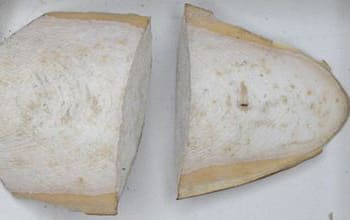
The unique properties of cuttlebone (see Cuttlefish Anatomy) have resulted in it being used since antiquity to make casts for metal. The model for the casting was pressed into the cuttlebone. When removed it left a clear, clean impression. Molten metals such as gold, silver or pewter could then be poured into the cast. As ancient as the practice is there are people in our modern world using the technique to produce individually unique works of art.
The Modern World
The desire to be able to produce materials with colour changing capabilities has led to research into engineering artificial chromatophores (as known from various animals) out of small devices known as dielectric elastomer actuators. Some years ago now Jonathan Rossiter and Andrew Conn, engineers at the University of Bristol, started developing soft materials that mimic the color-changing skin of animals like cuttlefish, paving the way for “smart clothing” and also for camouflage applications.
Cuttlefish Classification.
The 196 species of the order Sepiida are divided into three families and 21 orders.
Order Sepiida • 196 living spp.
- Family Sepiadariidae • 8 living spp.
- Genus Sepiadarium • 5 living spp.
- Genus Sepioloidea • 3 living spp.
- Family Sepiidae • 116 living spp.
- Genus Metasepia • 2 living spp.
- Genus Sepia • 107 living spp.
- Genus Sepiella • 7 living spp.
- Family Sepiolidae • 72 living spp.
- Genus Amphorateuthis • 1 living spp.
- Genus Austrorossia • 5 living spp.
- Genus Choneteuthis • 1 living spp.
- Genus Euprymna • 12 living spp.
- Genus Heteroteuthis • 7 living spp.
- Genus Inioteuthis • 3 living spp.
- Genus Iridoteuthis • 2 living spp.
- Genus Nectoteuthis • 1 living spp.
- Genus Neorossia • 2 living spp.
- Genus Rondeletiola • 1 living spp.
- Genus Rossia • 10 living spp.
- Genus Semirossia • 3 living spp.
- Genus Sepietta • 3 living spp.
- Genus Sepiola • 17 living spp.
- Genus Sepiolina • 2 living spp.
- Genus Stoloteuthis • 2 living spp.
If you would like to know more about cuttlefish why not visit:- Cuttlefish Anatomy
Offline References
- R. C. Brusca and G. J. Brusca; Invertebrates 2nd Edition Sinauer Associates (OUP) (2003)
- E. E. Rupert, R. S. Fox & R. D. Barnes; Invertebrate Zoology: A Functional Evolutionary Approach 7th Edition Cengage Learning (2003)
- Janet Moore; An Introduction to the Invertebrates Cambridge University Press (2006)
- Jan A. Pechenik; Biology of the Invertebrates McGraw-Hill Education (2015)
- G. Giribet & G. Edgecombe; The Invertebrate Tree of Life Princeton University Press (2020)
- Chongyun Liu and Angela Tseng; Chinese Herbal Medicine; Modern Applications Of Traditional Formulas CRC Press (2005)
- Gordon Lindsay Campbell Ed.The Oxford Handbook Of Animals In Classical Thought And Life OUP (2014)
Image Credits:- Cover Image by Joi Ito, Sepia latimanus by Paul Asman and Jill Lenoble, Flamboyant Cuttlefish (Metasepia pfefferi) by Bernard Dupont, Baby Cuttlefish by Peter from Edinburgh – License CC BY 2.0; Sepiella japonica by Liu L & Zhang Y et. al. License CC BY 4.0; Sepia latimanus by Rhododendrites License CC BY SA 4.0.

